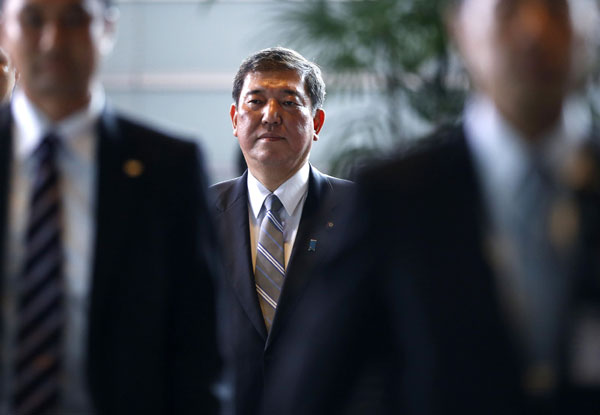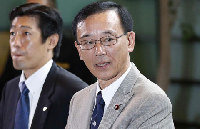 |
|
Japan's new minister for reviving regional economy Shigeru Ishiba (C) arrives at Prime Minister Shinzo Abe's official residence in Tokyo September 3, 2014.[Photo/Agencies] |
The reshuffle ushered in 12 new faces and five female ministers in the new 18-member lineup.
 |
| LDP unveils new executive lineup |
Shigeru Ishiba, who was replaced by Sadakazu Tanigaki as LDP's secretary general early Wednesday, was appointed as minister in charge of boosting regional economy, a post newly created in the cabinet reshuffle.
Ishiba's appointment was highlighted by local media as the former effective No. 2 figure in the LDP is seen as a key rival to Prime Minister Shinzo Abe, who also heads the LDP, in future party leadership race.
Abe's move to enroll Ishiba in the new cabinet lineup was read by analysts here to weaken the potential competitor and Ishiba's agreement to join in the cabinet was to avoid a factional conflict within the ruling party, according to local media.
Sanae Takaichi, former LDP's policy chief, replaced Yoshitaka Shindo as internal affairs and communication minister. Alike Shindo, Takaichi, among a group of Japanese lawmakers, promoted visits to notorious Yasukuni Shrine, which honors 14 class-A Japanese war criminals during the World War II.
Takaichi also publicly called for a new statement on comfort women issue in the 70th anniversary of the ending of WWII so as to replace the world-recognized"Kono Statement."
Akinori Eto, 58, replaced Itsunori Onodera as defense minister and doubled the newly created ministerial post of security legislation.
Yasuhisa Shiozaki and Koya Nishikawa were assigned as health, labor and welfare minister and agriculture, forestry and fisheries minister, respectively, while Yuko Obuchi and Midori Matsushima were named as economy, trade and industry minister and justice minister, respectively.
Eriko Yamatani was named as state minister in charge of abduction issue and Yoshio Mochizuki as environment minister, while Shunichi Yamaguchi was appointed as state minister for Okinawa and Northern Territories affairs and he also doubled as state minister for science and technology policy.
Haruko Arimura was appointed as minister in charge of mobilizing women workforce and Wataru Takeshita was named as state minister for disaster reconstruction.
Vice Prime Minister Taro Aso, who doubles as financial minister, Chief Cabinet Secreatry Yoshihide Suga, Foreign Minister Fumio Kishida, Education, Culture, Sports, Science and Technology Minister Hakubun Shimomura remained in their posts.
State Minister for Economic and Fiscal Policy Akira Amari, who is also in charge of affairs related to the Trans-Pacific Partnership, and Land, Infrastructure, Transport and Tourism Minister Akihiro Ota retained their posts.
Having five women in the Cabinet is extremely rare for Japan, and is the record number set in 2001. The previous Cabinet, dissolved earlier in the day, had two women ministers.
Abe has stressed his policies of economic growth center around utilizing the talent of women and empowering them. He has set the goal of having women in 30 percent of leadership positions by 2020.
The previous cabinet was launched in December 2012 and remained unchanged for about 20 months, creating a record for a postwar prime minister.
Support rate of the previous cabinet dropped to around 50 percent recently from a peak of over 70 percent due to the pass of Special Secrecy Bill and nod over Japan's Self-Defense Forces to exercise rights to collective self-defense, as well as sales tax hike carried out in April this year.
